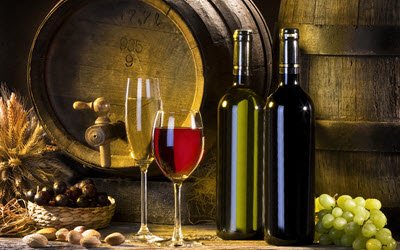No products in the cart.
Ten Alternative White Wine Varieties for you to Try
Chardonnay lost its charm? Another glass of Sauvignon Blanc seems boring? On a Pinot Grigio purge? Let us suggest a few alternatives to those wines you’ve come to love. Try something new. There are also a few that are a bit different, just for fun!
Like Sauvignon Blanc? Why not try….

Vermentino
Vermentino is a white Italian variety that is found in Sardinia, Tuscany and Liguria. Despite the often scorching summer temperatures, it makes a lovely crisp, refreshing highly scented wine with lots of citrus tang. The best examples come from hillier sites where the nights are cool, preserving freshness and flavour. In Sardinia, where the heat is tempered by constant sea breezes- the wine picks up a sort of sea saltiness. Like many other Italian wines, often an absolute bargain as they aren’t fashionable. Brilliant with many a seafood dish.
Burdizzo Vermentino, ASDA (£5.75)
M&S Vermentino Di Sardegna (£7.50)
M Signature Vermentino, Morrisons (£6)
Picpoul de Pinet
This is a somewhat strangely refreshing, almost Sauvignon Blanc like variety. This is in spite of its origins in the Mediterranean climes of the Languedoc in southern France. Its name literally means ‘lip-stinger!’ referring to its thirst quenching acidity. It has a fantastic aroma combination of apple, citrus, pear and orange blossom. Great for washing down seafood platters from the bountiful Med. and consumed by the gallon by thirsty tourists.
ASDA Picpoul de Pinet Blanc Sec, (£5.37)
Villemarin Picpoul de Pinet, Majestic, (From £7.49)
Tesco Finest* Picpoul de Pinet, Tesco, (£6)
Albarino
The signature white of Galicia in north west Spain, but also the main varietal of Vinho Verde of Portugal. Rias Baixas is the main producing region in Spain, which you often see on labels in the UK. The Spanish style is slightly fuller bodied in comparison to the spritzier Portugese- but both are dry wines, with a similar delicate, floral, peachy aroma and an attractive lemon colour. They are usually always unoaked in style too, as oak would obliterate such delicate flavours. Great with all kinds of foods.
Sainsbury’s Taste the Difference Albarino, (£8)
M Signature Albarino. Morrisons, (£8)
Bacchus
Many English still wines are produced from specially bred, rather obscure German varieties that can resist our somewhat wet, windy climate. This is the major challenge to grape growing in the UK. It’s not necessarily that we don’t get enough warmth- because in many places in the south east we do! (This is why many British vineyards are based on sunny south easterly facing slopes). However many of these, unfortunately, do not make fantastic wine.
Bacchus is by far the most promising. Largely displaced in its homeland Germany thanks to warmer climates, it quite happily thrives in the south of England. It produces an aromatic, green-floral wine with Sauvignon Blanc style citrus and gooseberry flavours. With much softer acidity than many New Zealand Sauvignon Blancs it is worth a try. And you will be supporting the still youthful English Wines industry.
These wines do tend to be at the dearer end on the table wine price list at the moment sadly, as much is still produced in small quantities. Often our very unpredictable weather limits how much can be made each vintage!
Lamberhurst Estate Bacchus Reserve, Chapel Down. M&S, (£13)
Chapel Down Flint Dry. Waitrose, (£9.99)
Like Pinot Grigio? Try….
Verdejo
Verdejo is the main variety of the up and coming white wine producing Rueda Valley, which neighbours Ribera del Duero in northwest Spain. This formerly rather obscure grape has been a blending component of many Spanish whites. It still does make blends here, labelled ‘Rueda’ – named after the principal region for this grape. However, at least 75% has to be made up of it in the blend if labelled this way. It usually makes a harmonious partner to Sauvignon Blanc.

Recent advances in wine making technology have allowed it to really shine as an excellent quality, standalone wine. It is a bit fuller textured than the more fashionable Albarino, and provides more obvious stonefruit and citrus flavours. This makes it a more pleasing one to quaff on its own, being a bit less delicate than its Galician neighbour. A great food partner too, usually a fraction of the price, being less well known and marketed than Albarino.
Nekora Rueda Verdejo, M&S (£9.99)
Marques Riscal Rueda Blanco, Majestic Wine (From £6.99)
M Signature Rueda Vedejo, Morrisons (£6)
Enjoy Chardonnay? Give these a go….
Viognier
Viognier hails from the northern Rhône Valley in France, where it is responsible for one of the only white wines produced there- Condrieu. Its enticingly silky, rich texture and attractive stone fruit perfume have won it many fans in the Languedoc, and New World countries like Chile and Australia. If you’re looking for a change from Chardonnay, and don’t like oaky flavours this is a good one to try. Its fruity characters mean that it doesn’t need the oak treatment to shine.
ASDA Extra Special Viognier, France (£6)
Cono Sur Bicicleta Viognier, Chile. Tesco, (£7)
Yalumba ‘Y’ Series Viognier, Australia. Sainsbury’s, (£10)
M Signature Viognier, France. Morrisons (£7)
Marsanne/Roussanne
Often blended together as they have similar flavours, and quite similar to Viognier if you get a really good one. Stone fruit, almond and sometimes toasted nuts, honey and caramel. This is not surprising, as this variety also comes from the warmer climes of the Rhône Valley, making these rich textured too.
These varieties are responsible for the tiny quantities of white wines made in this red dominated area. Everyone assumes Châteauneuf-du-Pape, Crozes-Hermitage and Hermitage make red wines only. However, they are also permitted to make white wines from these grapes.
Expect to pay higher premiums than for the reds though! Fortunately, the quality potential of these varieties has not gone unnoticed in the Languedoc and the New World. You can find many high quality examples from Australia, California and South Africa where these warmth loving varieties thrive.
ASDA Wine Atlas Series Marsanne, France (£5.47)
Exquisite Collection Marsanne, France. ALDI,(£5.49)
Domaine Sainte Rose ‘Le Marin Blanc’ Marsanne/Roussanne Côtes de Thongue, France. Majestic, (From £7.99)
Or how about something just a bit different?
Gewurztraminer
This unusual variety gets its name from a very aromatic, ‘spicy’ nature that is displayed wherever in the world it is grown. It has intense aromas of rose, lychee, Turkish delight, sweet spice and honey. Usually off dry to very sweet in style it emphasizes these lovely aromas, and makes some fantastic dessert wines with its pleasing mouth coating texture.
The grapes have a light pink tinge to them, which gives the wine an often deep lemon, sometimes golden colour. The very best examples come from Alsace in France, but as with many other of the unusual varieties in this list, curious winemakers the world over have tried their hand at experimenting with it, and are producing equally impressive examples. In fact, one of the most widely grown grapes in this list is found in Germany, Switzerland, Austria, Italy, California, Washington, Oregon, Australia, New Zealand and Chile.
M Signature Alsace Gewurztraminer, France. Morrisons (£8)
Sainsbury’s Taste the Difference Alsace Gewurztraminer, France. (£8)
Torrontes
This is another highly aromatic wine on our list, currently being pioneered by Argentina as their signature white. It is a light yellow wine that occasionally has golden and green hues and an attractively exotic nose, similar to Gewurztraminer. However, it is a bit more restrained. The aroma is reminiscent of roses, jasmine, and geraniums. In the mouth it is pure fruit salad, sometimes with touches of honey. Its aromas suggest a sweet wine but its taste reveals a refreshing acidity.

Viñalba Selección Torrontés, Argentina. Majestic (From £7.99)
M Signature Torrontes, Argentina. Morrisons (£7)
Riesling
Riesling makes truly unique wines. Unlike many other white varieties it can make fantastic wines to be appreciated young, and has the potential for developing lots of additional layers of flavour if given time to age.
It is however a very fickle and fussy grape- not liking conditions too hot or cold, too high or too flat. The steep, cooler but sloping sun trap, sun absorbing slate vineyards of sites in Germany, Austria, Alsace, Clare and Eden Valleys in Australia make world class examples at all price points- Dry and sweet. Delicate aromas of apple, citrus, stone fruit, stony minerals and flowers in youth evolve into a richer, more honeyed character.
In some cases it has an unusual ‘petroleum’ nose unique to this variety, which people who enjoy the smell of petrol stations are sure to appreciate!
Dr L Riesling, Germany. Widely Available, (From £7)
Exquisite Collection Clare Valley Riesling, Australia. ALDI, (£6.99)
Taste the Difference Awatere Valley Riesling, New Zealand. Sainsbury’s, (£8)



Leave a Reply